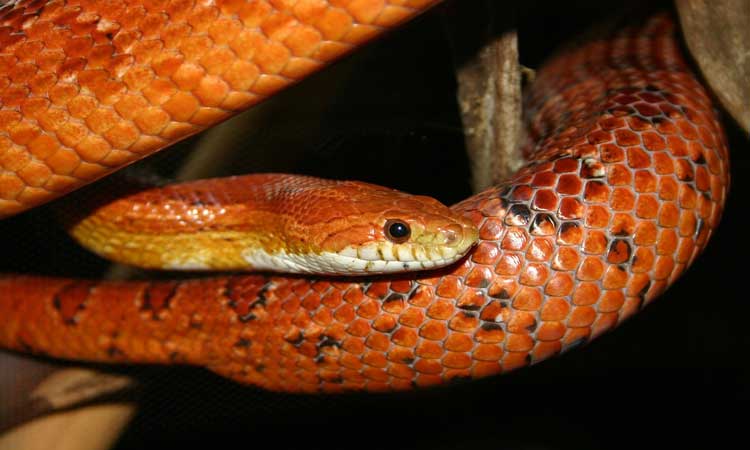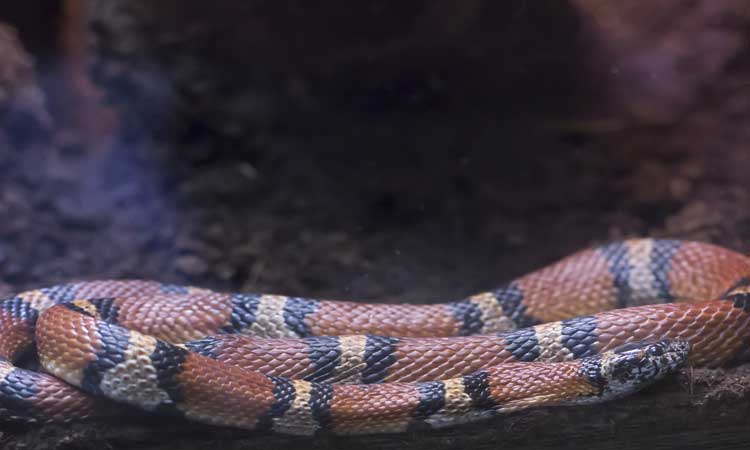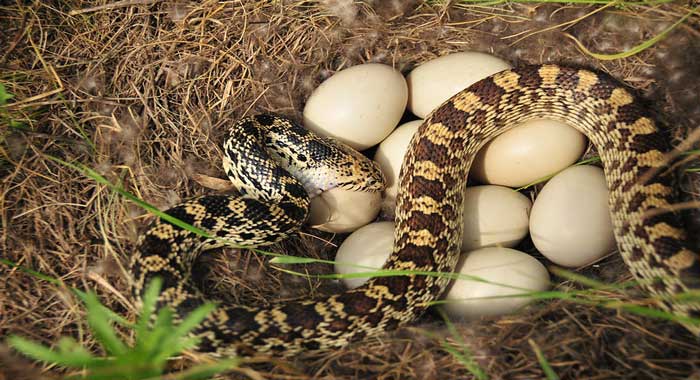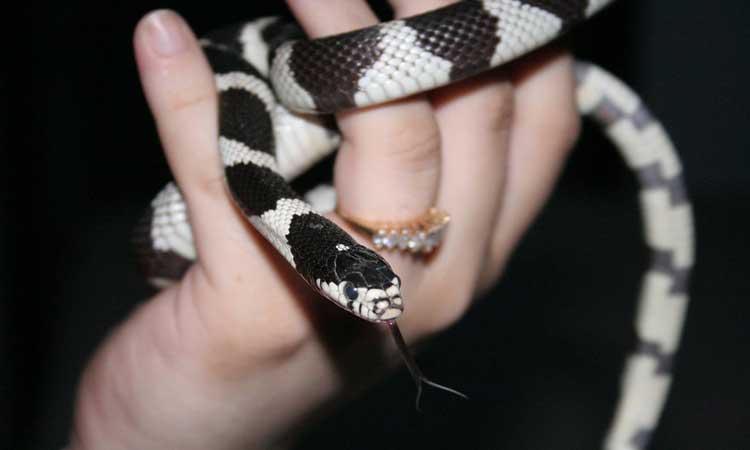Snakes are fascinating creatures that can make great pets for the right person. However, not all snakes are created equal. Some species are more aggressive and dangerous than others. If you’re thinking about getting a snake, it’s important to do your research and choose a species that is known for being docile and safe.
The 10 Safest Snakes to Own
In this article, we will discuss the safest snakes to own. We will also provide tips on how to choose the perfect snake for you and your family.
Corn Snake

Corn snakes are some of the safest snakes to own as pets. Their docile temperament, manageable size, and ease of care make them an excellent choice for both beginners and experienced reptile enthusiasts. These colorful, non-venomous snakes are known for their striking patterns, which resemble Indian corn, hence their name. Corn snakes are generally low-maintenance, requiring a simple setup and a consistent feeding schedule. If you’re looking for a safe and beautiful snake to add to your collection, consider the Corn Snake as a top choice.
Ball Python
Ball Pythons are often at the top of the list when it comes to the safest snakes to own. These gentle giants are known for their calm disposition and manageable size, making them perfect for novice snake keepers. Ball Pythons are also highly adaptable and can thrive in a variety of environments. Their docile nature and beautiful patterns make them a popular choice among reptile enthusiasts. When looking for a safe and easy-to-care-for snake companion, the Ball Python is a top contender.
Kingsnake
Kingsnakes are among the safest snakes to own, thanks to their non-aggressive nature and manageable size. With their striking coloration and pattern variations, these snakes are not only easy to care for but also visually appealing. Kingsnakes are known for their resistance to snake mites, making them a practical choice for pet owners. Their robust appetite and general hardiness make them a great option for those new to snake ownership. When considering the safest snakes to add to your collection, don’t overlook the charm and reliability of the Kingsnake.
Milk Snake

Milk snakes are a safe and attractive choice for reptile enthusiasts. With their vibrant colors and striking bands, they mimic the appearance of the venomous coral snake, but they are completely harmless. This mimicry, known as Batesian mimicry, serves as a defense mechanism. Milk snakes are generally docile and easy to handle, making them suitable for snake keepers of all experience levels. Their manageable size and straightforward care requirements make them a great addition to any collection. When seeking one of the safest snakes to own, the Milk Snake is a captivating and low-risk choice.
Garter Snake
Garter snakes are some of the safest snakes to own, especially for beginners. These small to medium-sized snakes have a mild disposition and rarely bite. They are known for their distinctive stripes and are often found near water sources. Garter snakes are relatively easy to care for, requiring a simple enclosure and a diet of small prey items. Their curious and active nature makes them interesting to observe. If you’re new to snake ownership and looking for a safe and low-maintenance option, consider the Garter Snake as a top choice.
California Kingsnake
The California Kingsnake is renowned as one of the safest snakes to own. Their striking black and white bands are not only visually appealing but also serve as a form of mimicry to deter predators. These snakes are docile and relatively easy to care for, making them an excellent choice for snake enthusiasts of all levels. California Kingsnakes are known for their appetite, often readily accepting a variety of prey items. When seeking a safe and attractive snake to add to your collection, the California Kingsnake is a top contender.
Western Hognose Snake
Western Hognose Snakes are considered safe snakes to own, particularly for those new to reptile keeping. Their unique upturned snouts and varied coloration make them stand out in the world of snakes. While they may exhibit some defensive behaviors like hissing and playing dead, their bites are generally non-venomous and harmless to humans. These small to medium-sized snakes are relatively low-maintenance and can thrive in captivity with the right care. If you’re looking for an intriguing and safe snake companion, consider the Western Hognose Snake.
Rosy Boa
Rosy Boas are among the safest snakes to own, known for their gentle disposition and manageable size. These snakes are named for their rosy or pinkish hues and are highly sought after by reptile enthusiasts. Rosy Boas are easy to care for and can thrive in a variety of enclosures. They are generally non-aggressive and well-suited for snake owners of all experience levels. When searching for a safe and visually appealing snake, the Rosy Boa is a top choice that can bring both beauty and ease of care to your reptile collection.
Rubber Boa
Rubber Boas are unique and safe snakes to own, with a reputation for their docile nature and unusual appearance. These small, stout-bodied snakes have a rubbery texture and are known for their ability to squeeze into tight spaces. Rubber Boas are generally calm and non-aggressive, making them a great option for those new to snake-keeping. Their modest size and straightforward care requirements make them an excellent choice for snake enthusiasts seeking a safe and distinctive pet.
Sand Boa
Sand Boas are considered safe snakes to own due to their manageable size and low-maintenance care requirements. These snakes are known for their burrowing behavior and are often found in sandy habitats. Sand Boas are generally docile and well-suited for novice snake keepers. They have a unique appearance with their short, stout bodies and distinctive head shapes. If you’re looking for a safe and fascinating snake companion that’s relatively easy to care for, the Sand Boa is worth considering for your reptile collection.
What to Feed Your Snake
Feeding your pet snake is a crucial aspect of responsible snake ownership. When it comes to providing a safe and healthy diet for your snake, understanding the nuances of what to feed is essential. This article explores the key considerations, keeping ‘Safest Snakes to Own’ in mind.

Diet of Wild-Caught vs. Captive-Bred Prey
The source of your snake’s food plays a significant role in its overall health. Opting for captive-bred prey items is generally safer. Wild-caught prey can introduce parasites and diseases to your snake, potentially compromising their well-being. Captive-bred rodents, such as mice and rats, are readily available and less likely to pose health risks to your pet.
How Often to Feed
The frequency of feeding largely depends on your snake’s age and species. Young snakes typically require more frequent meals, sometimes weekly, while adults can go for longer periods between feedings. It’s essential to research your snake’s specific dietary needs to establish an appropriate feeding schedule.
How Much to Feed
Determining the right portion size is crucial to avoid overfeeding or underfeeding. A good rule of thumb is to offer prey items that are about the same width as the widest part of your snake’s body. This ensures that the meal is appropriately sized and won’t lead to digestion issues.
Snake Handling and Safety
Handling snakes, especially when you own the ‘Safest Snakes to Own,’ requires care and attention to both your safety and the well-being of your pet. Here, we’ll discuss essential guidelines for snake handling and what to do in case of a snake bite.

How to Handle Your Snake Safely
Approach Calmly: Move slowly and confidently when handling your snake. Sudden movements may startle them.
Support Their Body: Always support the full length of your snake’s body. A snake’s spine is delicate, and improper handling can cause injury.
Wash Hands: Before and after handling your snake, wash your hands thoroughly to prevent the transmission of any potential pathogens.
Use Proper Tools: Consider using a snake hook or tongs for initial handling, especially if your snake is new or maybe nervous.
What to Do If Your Snake Bites You:
Stay Calm: If your snake bites, stay as calm as possible. Most pet snakes are non-venomous and their bites are generally not harmful.
Gently Remove: If the snake doesn’t release on its own, gently pry its jaws open with a dull object. Do not pull or jerk.
Wash the Wound: Clean the bite wound thoroughly with soap and warm water to prevent infection.
Seek Medical Attention: Even if the snake is non-venomous, seek medical attention if you experience unusual symptoms, an allergic reaction, or if you’re uncertain about the snake’s species.
By following these guidelines, you can enjoy the company of your snake safely while ensuring the ‘Safest Snakes to Own’ remain content and stress-free during handling.
Veterinarian Care for Snakes
Providing proper veterinary care for your pet snakes, especially the ‘Safest Snakes to Own,’ is crucial to ensure their well-being and longevity. In this guide, we’ll discuss when to seek veterinary assistance and common health issues to watch for.
When to Take Your Snake to the Vet
Regular Check-Ups: Just like any other pet, snakes benefit from routine veterinary check-ups. Annual visits allow the vet to assess their overall health and detect any potential issues early.
Signs of Illness: Keep a close eye on your snake for signs of illness, such as loss of appetite, lethargy, difficulty breathing, or unusual skin changes. If you notice any of these, consult a veterinarian promptly.
Shedding Problems: Snakes commonly shed their skin. However, difficulties in shedding, such as retained eye caps or incomplete sheds, may require veterinary attention.
Common Snake Health Problems:
Respiratory Infections: Snakes can develop respiratory infections due to poor husbandry, stress, or temperature fluctuations. Symptoms include wheezing and excessive mucus production.
Mites and Parasites: External parasites like mites can infest snakes. These tiny pests can cause skin irritation and stress to your pet.
Digestive Issues: Problems like constipation or impaction can occur if a snake ingests substrate or objects they can’t digest. This may require veterinary assistance.
Mouth Rot: Also known as stomatitis, this bacterial infection can affect a snake’s mouth. It’s characterized by swelling, redness, and difficulty eating.
Regular veterinary care and prompt attention to health issues are essential to ensure the well-being of your ‘Safest Snakes to Own.’ Always consult a qualified reptile veterinarian for professional guidance and care.
What to Consider When Choosing a Snake
There are many factors to consider when choosing a snake. Here are a few of the most important ones:
Temperament: Some snakes are more aggressive than others. If you have children or other pets, it’s important to choose a snake with a calm and docile temperament.
Size: Snakes come in all shapes and sizes. Consider how much space you have available when choosing a snake.
Care requirements: Snakes have different care requirements. Some snakes are more difficult to care for than others. Do your research to make sure you can meet the needs of the snake you choose.
Cost: Snakes can range in price from a few dollars to several hundred dollars. Set a budget before you start shopping.
Tips for Choosing the Perfect Snake
Here are a few tips for choosing the perfect snake for you:
Visit a local pet store or reptile expo and talk to the staff. They can help you choose a snake that is right for you.
Do your research online. There are many resources available that can help you learn about different snake species.
Be patient. It may take some time to find the perfect snake for you.
Conclusion
Snakes can make great pets, but it’s important to choose the right species for you. The safest snakes to own are those that are docile, easy to care for, and not aggressive. By following the tips in this article, you can choose the perfect snake for your family.
Here are some additional tips for keeping snakes as pets:
Provide your snake with a secure enclosure that is the appropriate size for its species.
Keep the enclosure clean and well-ventilated.
Provide your snake with a heat source and a hide box.
Feed your snake a diet of appropriately sized prey items.
Take your snake to the veterinarian for regular checkups.
By following these tips, you can help ensure that your snake has a long and healthy life.

